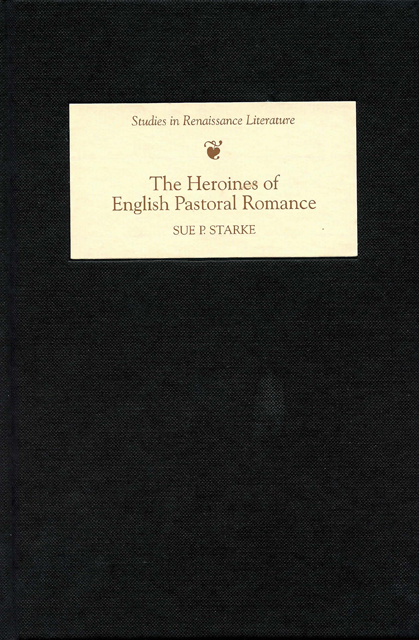Book contents
- Frontmatter
- Contents
- Acknowledgements
- Abbreviations
- Chapter 1 The Pastoral Romance Heroine in English Renaissance Literature
- Chapter 2 The Arcadian Prison: Chastity and the Defense of the Princesses in Sidney's Two Arcadias
- Chapter 3 Spenser's Romance Heroines: The Heroic and the Pastoral in Books 3 and 6 of The Fairie Queene
- Chapter 4 Growing Out of Pastoral: Wroth's Urania and the Female Pastoral Career
- Chapter 5 Fletcher's Clorin and Milton's Lady: The Performance of Chastity in Pastoral Drama
- Chapter 6 Milton's Eve and Marvell's Maria Fairfax: Wives and Daughters in the Pastoral Family Circle
- Bibliography
- Index
Chapter 3 - Spenser's Romance Heroines: The Heroic and the Pastoral in Books 3 and 6 of The Fairie Queene
Published online by Cambridge University Press: 10 March 2023
- Frontmatter
- Contents
- Acknowledgements
- Abbreviations
- Chapter 1 The Pastoral Romance Heroine in English Renaissance Literature
- Chapter 2 The Arcadian Prison: Chastity and the Defense of the Princesses in Sidney's Two Arcadias
- Chapter 3 Spenser's Romance Heroines: The Heroic and the Pastoral in Books 3 and 6 of The Fairie Queene
- Chapter 4 Growing Out of Pastoral: Wroth's Urania and the Female Pastoral Career
- Chapter 5 Fletcher's Clorin and Milton's Lady: The Performance of Chastity in Pastoral Drama
- Chapter 6 Milton's Eve and Marvell's Maria Fairfax: Wives and Daughters in the Pastoral Family Circle
- Bibliography
- Index
Summary
Edmund Spenser's great mixed-mode romance The Faerie Queene (1591; 1596) is a capacious catalogue of Renaissance heroic archetypes. Not surprisingly, it offers its own shifting reflections of romance heroism between the chivalric and the pastoral generic models. Spenser's most extensive engagement with pastoral takes place in Book 6, the book of Courtesy. The shepherdess Pastorella, the beloved of the hero Calidore, provides a more typical model of the heroine of English Renaissance romance than does Britomart, the female knight of Chastity in Book 3. It is the last book, then, that provides an example of the “new” romance heroine who carries the honor of the class and line. Within the overall context of The Faerie Queene, Pastorella is undoubtedly a minor character, and I do not mean to suggest that she is more important to a comprehensive interpretation of Spenser's work than Britomart is. By comparing the two, however, we may develop a keener sense of the divisions between the chivalric and pastoral versions of romance honor as they relate to the virtue of the well-born girl. Each offers a different answer to the question: how does a romance heroine prove herself to be physically pure and ethically worthy?
In his 1590 “Letter of the Authors” to Sir Walter Raleigh, Edmund Spenser emphasizes the didactic impulse behind his work: The Faerie Queene is “to fashion a gentleman or noble person in vertuous and gentle discipline” (Spenser, FQ, 737). Although the intended reader in this letter appears to be masculine, elsewhere in the text we may see how Spenser assumed a female readership as well, most notably in his address to Elizabeth I in the Proem to Book 3: “But O dred Soueraine/Thus farre forth pardon, sith that choicest wit/ Cannot your glorious portraict figure plaine; /That I in colourd showes may shadow it, And antique praises unto present persons fit” (Proem 2). Both forms of romance honor, the chivalric and the pastoral, rely on the observance of moral and social norms best described as courtesy.
- Type
- Chapter
- Information
- The Heroines of English Pastoral Romance , pp. 86 - 106Publisher: Boydell & BrewerPrint publication year: 2007



